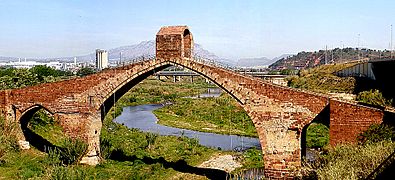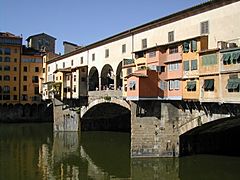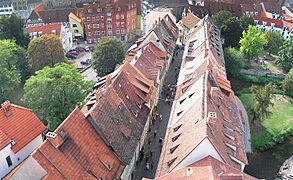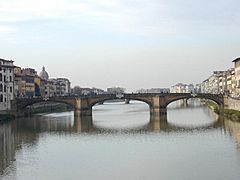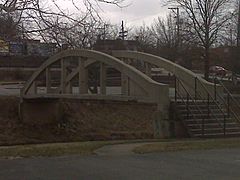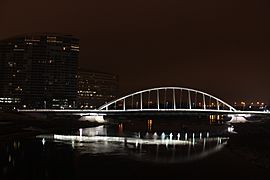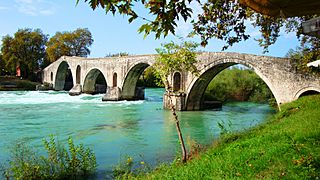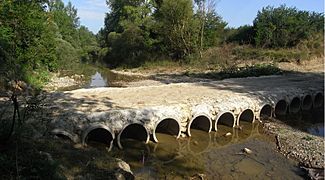Arch bridge facts for kids
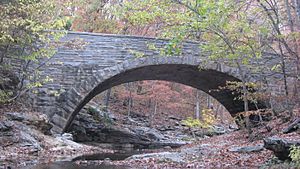
An arch bridge is a type of bridge that has a curved shape, like an arch. It uses strong supports called abutments at each end. These bridges work by pushing the weight of the bridge and anything on it outwards and downwards. This force, called "thrust," is then held by the abutments on either side. A very long bridge, called a viaduct, can be made from many arches in a row. Today, other types of bridges are often built because they can be cheaper.
Contents
History of Arch Bridges
The oldest arch bridge we know of is the Arkadiko bridge in Greece. It was built around 1300 BC by the Mycenaeans. This stone bridge, made with a special "corbel arch," is still used today! Another old bridge, the Eleutherna Bridge, has a triangular corbel arch. The Rhodes Footbridge from the 4th century BC uses an early type of arch made from wedge-shaped stones called voussoirs.
Even though the Etruscans and ancient Greeks knew about arches, the Romans were the first to use them widely for building bridges.
Roman arch bridges were usually shaped like a half-circle. Some were also "segmental arch bridges," meaning their curve was less than a half-circle. Segmental arches were great because they let a lot of flood water pass underneath. This helped stop the bridge from being washed away during floods. These bridges could also be lighter. Roman bridges often had wedge-shaped stones (voussoirs) that were all the same size. The Romans built both single-arch bridges and very long ones, like their famous aqueducts. Their bridges also had openings in the piers (the supports between arches) to let floodwaters through.
During the Middle Ages in Europe, bridge builders got even better. They made piers narrower and arches thinner. They also started using Gothic pointed arches. These pointed arches helped reduce the outward push on the abutments. The 14th century was a big time for bridge building. Builders could create masonry (stone) arches that spanned up to 40 meters (about 130 feet), which was amazing for that time!
How Simple Arch Bridges Work
Strong Materials
Materials like stone and brick are very strong when you push on them (this is called compression). They are also quite strong against twisting or sliding forces (called shear). However, they are not good at resisting pulling forces (called tension). Because of this, stone arch bridges are designed to always be under compression.
Each arch is built on a temporary wooden frame called a centring (or falsework). In the first arch bridges, a special stone in the middle, called a keystone, held the weight of the rest of the bridge. The more weight that was put on the bridge, the stronger it became! Masonry arch bridges often have rubble (broken stones) packed above the arch. This adds weight and helps keep the arch in compression, even when traffic moves across it. Unreinforced concrete can also be used in a similar way. When builders use cut stones, they shape the angles to reduce shear forces. If they use uncut stones, they are held together with mortar. The mortar must dry and harden before the wooden frame is removed.
Building Steps
Here's how a simple arch bridge is built:
- Preparing the Base: If the arches will be in a river or stream, the water is moved away. Then, the ground (often gravel) is dug out and replaced with a strong base, called a "footing." From these footings, the foundation piers are built up to the height where the arch will begin. This point is called the springing.
- Building the Frame: A temporary wooden frame, the centering, is built. For bridges with many arches, all the arches usually need to be built at the same time. This is because each arch pushes against the ones next to it. The arches at the very ends of the bridge push against strong, vertical supports built into the canyon walls or riverbanks.
- Constructing the Arch: The arches are built over the wooden frame. Once the main arch shape, called the arch barrel, is finished, it's made stronger by filling in the space above it with stone. This often involves building two outer walls, called spandrels, and then filling the space between them with loose material and rubble.
- Finishing Touches: Finally, the road surface is paved. Walls called parapets are built along the sides to guide traffic safely across the bridge.
Gallery
-
Fredrikstad bridge in Fredrikstad, Norway
-
Bridgeport Lamp Chimney Company Bowstring Concrete Arch Bridge located in Bridgeport, West Virginia
-
The Main Street Bridge in Columbus, OH is the only inclined-arch suspension bridge in North America.
-
Bridge of Arta in Arta, Greece
Images for kids
-
The Roman Alcántara Bridge, Spain (built 103-106 AD)
-
Segovia Aqueduct (around 100 AD)
-
Devil's bridge, Céret, France (1341)
-
The Ponte Vecchio, Florence, Italy (1345)
-
Richmond Bridge, oldest working bridge in Australia (1825)
-
Falsework centering in the center arch of Monroe Street Bridge, Spokane, Washington. 1911.
-
Cotter Bridge, a through arch bridge that has open spandrels
-
Corbel arch built from Cyclopean masonry, in the Greek Arkadiko bridge
-
Corbel arch in the shape of an isosceles triangle, supporting the Greek Eleutherna Bridge
-
Roman Pont-Saint-Martin
-
The three-story Roman Pont du Gard aqueduct
-
One arch bridge Stari most in Mostar Bosnia and Herzegovina
-
Rialto Bridge over the Grand Canal in Venice, Italy (2011)
-
The Main Street Bridge in Columbus, OH is the only inclined-arch suspension bridge in North America.
-
The dry stone bridge, so called Porta Rosa (4th century BC), in Elea, Province of Salerno, Campania, Italy (2005)
-
Pont du Garde, a Roman aqueduct in Vers-Pont-du-Gard, Gard, France (2014)
-
Union Arch Bridge carrying the Washington Aqueduct and MacArthur Boulevard (formerly named Conduit Road), Cabin John, Montgomery County, Maryland, U.S.A. (2008)
-
Arlington Memorial Bridge over the Potomac River in Washington, D.C., U.S.A. (2007)
-
Key Bridge over the Potomac River in Washington, D.C., U.S.A. (2006)
-
Woodrow Wilson Bridge carrying Interstate 95 (I-95) and the Capital Beltway over the Potomac River between Alexandria, Virginia and Oxon Hill, Maryland, U.S.A. (2007)
-
Tyne Bridge over the River Tyne, Newcastle upon Tyne, England, U.K. (2004)
-
Hell Gate Bridge over the East River, New York City, New York, U.S.A.
-
Sydney Harbour Bridge, Sydney, New South Wales, Australia (2010)
-
Gateshead Millennium Bridge over the River Tyne, Newcastle upon Tyne, England, U.K. (2005)
-
Bridge over the Autostrade A1 motorway in Reggio Emilia, Italy (2015)
-
Richmond Bridge, oldest working bridge in Australia (1825)
-
The three-story Roman Pont du Gard aqueduct
See also
 In Spanish: Puente en arco para niños
In Spanish: Puente en arco para niños


